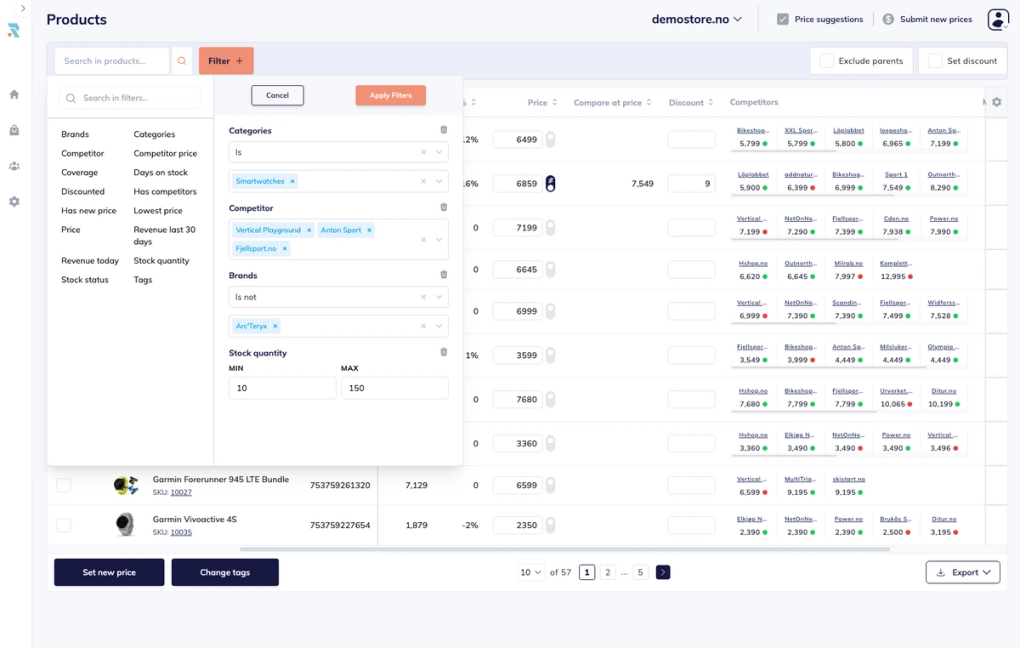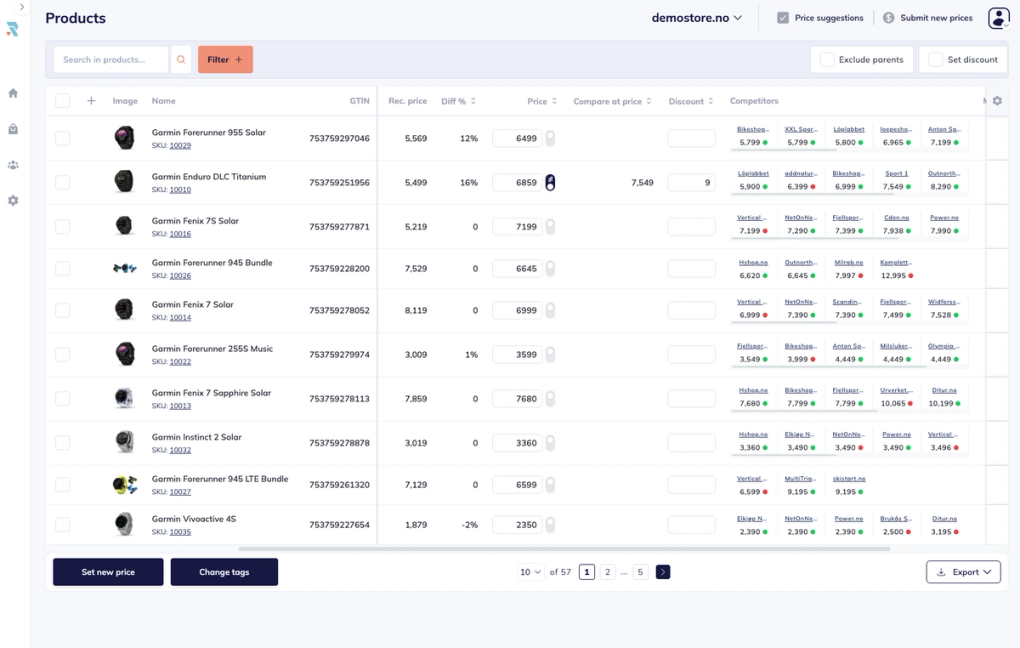5 Automation Tools You Need To Streamline Your Entire E-Commerce Pricing Process
September 14, 2023 | 10 minutes read
As an e-commerce manager, say you’re navigating the ever-changing digital realm of laptop and smartphone shopping. Competitor moves, shifting demand and new launches are constantly keeping prices in motion.
Being able to successfully navigate the flux requires way more than manual effort - you need technology and data.
Now, imagine a huge smartphone release coming up. Your competitors are primed to adjust their prices to increase their competitive advantage.
Your role as an e-commerce manager?
Implementing a strategy that not only matches this ever-changing landscape, but also capitalizes on it: Boosting revenue and sales.
So, how do you make this careful balance work?
By leveraging automation tools.
In this article, we’ll take a look at 5 automation tools e-commerce companies need in order to streamline their pricing process.
Table of contents:
- Challenges of manual pricing
- The importance of streamlining your pricing process with automation
- 5 automation tools to streamline the pricing process
- Why you should choose Reprice as your automation tool
- Conclusion
The challenges of manual pricing
Nordic e-commerce companies often end up wasting hours scrutinizing their competitors' prices to ensure their own products remain competitive - and they typically store this data in an Excel spreadsheet.
Here’s three main challenges companies face when it comes to manually pricing their products:
- Inconsistencies and human inaccuracies: Manual pricing procedures are particularly vulnerable to inaccuracies stemming from data input errors, miscalculations, and inconsistencies.
Even the slightest oversight may lead to substantial variations in pricing. The outcome? Possible financial setbacks or customer discontentment.
- It’s time-consuming: Figuring out prices usually means looking at a bunch of information like what's happening in the market, what your competitors are charging, and how well you've sold stuff before. When you do this by hand, it eats up a ton of time, causing delays in reacting to changes in the market. This problem could mean you miss out on making more money.
- Lack of scalability: As a business gets bigger, making pricing choices can get more complicated. When you have a lot of products, sell in different places, or use dynamic pricing strategies, doing it all by hand can become too hard and not very effective.
This means you might struggle to keep up with changes in the market and what your customers actually want.
The importance of streamlining your pricing process with automation tools
If you aren’t already investing in e-commerce automation, you’re about to.
The market for workflow automation was worth 8.07 billion USD in 2019. And it’s estimated to achieve a value of 39.49 billion USD by 2027, with a steady growth rate of 23.68% from 2020 to 2027.

Which means it's high-time that companies start embracing more automation in their everyday activities.
According to 70% of corporate executives, they dedicate between 45 minutes and 3 hours of their 8-hour workday to routine tasks.
Plus, a study by McKinsey found that 60% of workers could reclaim 30% of their time by implementing more workflow automation. On average, supervisors spend a full workday each week on data tasks. Additionally, a quarter of managers dedicate over 20 hours weekly to these duties.
What does this mean in practice?
A significant loss of time that could otherwise be used for important decision-making and higher-value activities. AKA, negatively affecting overall efficiency and productivity.
5 automation tools to streamline your pricing process
Here’s five automation tools you can use to streamline your entire pricing process from start to finish.
1. Reprice: A pricing optimization tool
Reprice helps you optimize your prices efficiently, ultimately helping you improve your profits and margins.
With Reprice, you'll simplify your pricing process, backed by real data. Here’s how:
- Real-time monitoring: Real-time data access allows you to gain a competitive edge. It also enables continuous tracking of market trends, competitor prices, and demand dynamics.
- Data analysis: The integrated dashboard empowers data-driven decisions by providing comprehensive sales and product performance insights from multiple sources. This helps you uncover patterns and current market trends to make better pricing decisions.
- Rule-based pricing: Reprice lets you automate pricing using your own rules that you define.
- Quick adjustments: As you have access to daily trend recommendations and that you can automate pricing based on rules you set, you can quickly respond to market changes. In other words, an easy way to make the most of new opportunities and monitor your competitors to increase your competitiveness.
One of the biggest benefits of Reprice is that you’re able to cut down on manual tasks, hindering efficiency. That’s the edge you need to stay toe-to-toe with your competitors in today’s volatile online market.
2. Klaviyo
Klaviyo is a tool used to streamline email marketing and eCommerce SMS.
It comes with tons of features that help you boost customer engagement and improve your marketing efforts:
- Automated workflows that handle multi-channel messaging (like SMS, emails, push notifications for triggers like cart abandonment).
- Customizable templates
- Web forms that make it easy to gather and analyze data
- Integrations with your e-commerce system, historical data and ecosystem
In short: Klaviyo unifies email, SMS, push, and reviews, integrating with numerous apps.
The result?
A streamlined marketing ecosystem that cuts down on manual tasks and increases efficiency - giving you time to focus more on optimizing your pricing strategy and boosting sales.
3. Forter
For a pricing process that's both secure and efficient, turn to Forter. This AI-powered platform specializes in fraud detection, employing machine learning to swiftly spot fraudulent activities and take real-time action to prevent chargebacks, safeguarding e-commerce businesses from financial losses.
Forter's Trust Platform covers a wide range of areas:
- Identity protection: Safeguarding digital identities from theft and misuse.
- ATO protection: Preventing Account Takeover (ATO) incidents.
- Fake account prevention: Blocking the creation of fake accounts.
- Fraud management: Offering comprehensive fraud management, including payment fraud prevention, chargeback reduction, and false decline reduction.
- Payment optimization: Streamlining payment processes with features like Smart 3DS and PSD2 Optimization.
- Chargeback recovery: Simplifying chargeback resolution with representment automation, dispute recommendations, and order & claim consolidation.
- Abuse prevention: Mitigating various forms of abuse, including Returns/Item-not-Received (INR) abuse, Promotion/Coupon abuse, and Reseller/Reshipper abuse.
With Forter, you can fortify your pricing process, ensuring both security and efficiency in the world of e-commerce.
4. Shipmondo
Shipmondo is a versatile tool that helps simplify your pricing and shipping processes.
At a glance, it brings together shipping services from various carriers, automating order processing for smoother operations. Which means you'll enjoy competitive shipping rates without the burden of subscriptions and effortlessly access international markets.
The seamless integration takes only a few minutes and enhances efficiency through features like digital picking routes, scanners, and terminals, reducing errors in order fulfillment.
Shipmondo even provides a branded return portal for hassle-free customer returns.
Its transparent pay-as-you-go pricing model ensures no hidden fees, helping you manage costs and refine your pricing strategies.
5. Ongoing WMS
Ongoing WMS is a helpful tool designed to offer quick and easy warehouse management. It streamlines your pricing processes by providing real-time access to stock volumes and orders, seamless integration with external systems, and customizable automation solutions.
It’s used by a wide range of logistics providers, including Colliflow, 360Logistics, and Accelerator.
Ongoing streamlines pricing processes by offering remote access to the WMS from any device at any time. Customers and suppliers gain the ability to review their stock volumes and orders, while seamless integration with external systems, including transport management and ERP systems, is ensured, all while maintaining data security.
The platform provides pre-built integrations with popular platforms or the option to leverage the open API for custom solutions. Additionally, for automation systems such as conveyor belts or picking systems, the automation API is available.
Why choose Reprice as your main automation tool
Out of all these tools, we recommend choosing an automation tool that is solely focused on pricing if you’re looking to streamline your pricing process.
Instead of spending hours or days storing data in outdated Excel spreadsheets, Reprice tackles this issue by enabling you to manually change or automate product prices in response to market chances, demand variations, and seasonal patterns.
By using Reprice, you shift from a reactive pricing approach to a more proactive one:
- Rule-based automation: Use Reprice to set rules based on category, brand or competition to automate your pricing. This helps you shift from reactive to proactive pricing strategies.
- You get a complete overview: Reprice gives you access to integrated reports and key statistics from all your connected data sources through Reprice's dashboard.
- Competitor insights: Use Reprice to access real-time competition data. That results in more agile pricing tactics and strategies that are actually aligned with the evolving market conditions.
- Increased pricing control: The tool lets you manually adjust prices based on campaigns, discounts, and seasonality. The result? Swift responses to current market trends.

- Data-driven recommendations at your disposal: Get your hands on daily price suggestions customized to your guidelines. This means you can much more quickly act on strong-margin items or high-demand products.
- Integration with Google Merchant Center: Swiftly upload products to Google Merchant Center to improve your shopping ads and track their effectiveness.
- Platform integration: The tool integrates with your ERP, PIM and other e-commerce platforms. The result? Two-way product data exchange systems, getting rid of manual data handling.

Conclusion
We’ve gone through 5 different automation tools that e-commerce companies can use to streamline their pricing process: Reprice, Klaviyo, Forter, Shipmondo and Ongoing WMS.
Although all tools come with extensive features and benefits, we recommend that you choose a pricing optimization tool like Reprice to make your pricing process more efficient.
Why?
Because with Reprice you get the flexibility to adjust product prices either manually or through automated processes, according to the specific rules you set.
Plus, you can easily compare against competitors, automate price updates across online and offline stores and apply bulk price changes for specific brands/items.
Ready to get started with Reprice?
Robin Frugaard Jørgensen
Chief Commercial Officer at Reprice
Robin Frugaard Jørgensen is Chief Commercial Officer at Reprice. Prior to joining Reprice in January 2023, Robin spent several years working with pricing strategies in B2B & the consumer electronics industry. Connect with Robin on LinkedIn here or book a demo to see how Reprice can solve your e-commerce pricing challenges.
